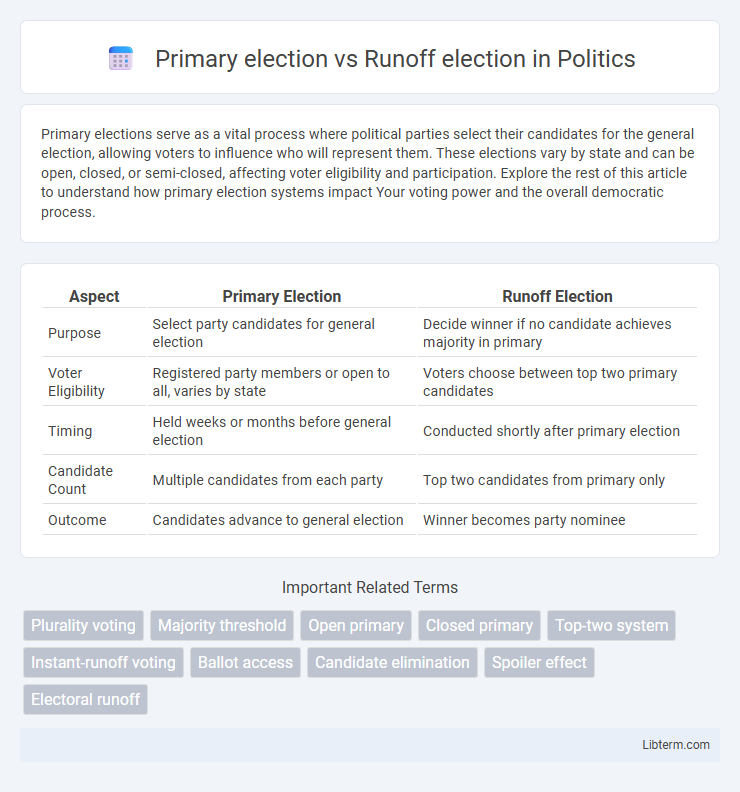Primary elections serve as a vital process where political parties select their candidates for the general election, allowing voters to influence who will represent them. These elections vary by state and can be open, closed, or semi-closed, affecting voter eligibility and participation. Explore the rest of this article to understand how primary election systems impact Your voting power and the overall democratic process.
Table of Comparison
| Aspect | Primary Election | Runoff Election |
|---|---|---|
| Purpose | Select party candidates for general election | Decide winner if no candidate achieves majority in primary |
| Voter Eligibility | Registered party members or open to all, varies by state | Voters choose between top two primary candidates |
| Timing | Held weeks or months before general election | Conducted shortly after primary election |
| Candidate Count | Multiple candidates from each party | Top two candidates from primary only |
| Outcome | Candidates advance to general election | Winner becomes party nominee |
Introduction: Understanding Electoral Processes
Primary elections determine a political party's candidate for the general election by allowing registered party members to vote. Runoff elections occur when no candidate achieves the required majority in the primary or general election, prompting a follow-up vote between the top contenders. These electoral processes ensure the selection of candidates with broad support and maintain democratic legitimacy.
What Is a Primary Election?
A primary election is a preliminary voting process where party members select their preferred candidate to represent them in the general election. This election narrows the field of candidates by allowing voters to choose among multiple contenders within the same political party. Primary elections vary by state, including open, closed, and semi-closed formats, each determining voter eligibility based on party affiliation.
Types of Primary Elections
Types of primary elections include closed, open, semi-closed, and blanket primaries, each determining voter eligibility and ballot access differently. Closed primaries restrict voting to registered party members, while open primaries allow any registered voter to participate regardless of party affiliation. Runoff elections occur when no candidate meets the required vote threshold in the primary, necessitating a second election between the top contenders.
Defining Runoff Elections
Runoff elections occur when no candidate achieves the required majority in a primary election, necessitating a second round between the top contenders. This system ensures that the winning candidate has broad support, typically requiring more than 50% of the vote. Runoff elections are common in states like Georgia and Louisiana, where they help prevent plurality winners with less than majority support.
Key Differences Between Primary and Runoff Elections
Primary elections allow political parties to select their candidates for the general election by voters casting ballots within their party. Runoff elections occur when no candidate achieves the required majority in the primary, leading the top two candidates to compete for the final nomination. The key difference lies in the primary serving as the initial candidate selection process, while the runoff ensures a majority winner when the primary vote is split.
The Purpose and Importance of Primaries
Primary elections serve to narrow the field of candidates within a political party by allowing registered voters to select their preferred nominee for the general election. These elections are crucial for ensuring that the final candidate reflects the choice of party members, enhancing democratic participation and legitimacy. Runoff elections occur only if no candidate achieves the required majority in the primary, guaranteeing that the nominee has broad support within the party.
How Runoff Elections Work
Runoff elections occur when no candidate achieves the required majority in the primary election, typically over 50% of the votes. The top two candidates from the primary face off in a subsequent runoff election to ensure the winner secures a majority. This system promotes voter majority consensus and reduces the likelihood of a candidate winning with only a plurality.
Advantages and Disadvantages of Each System
Primary elections enable a broad field of candidates to compete, often increasing voter engagement and representing diverse party preferences, but they risk vote splitting and may not always produce a majority winner. Runoff elections ensure the winning candidate secures an absolute majority by pitting the top contenders in a second round, enhancing legitimacy and voter consensus, yet they involve higher costs, extended campaign periods, and reduced turnout in the follow-up vote. Both systems balance inclusivity and decisiveness, with primaries favoring initial wide participation and runoffs emphasizing majority mandate and electoral clarity.
Impact on Voter Turnout and Election Outcomes
Primary elections typically experience higher voter turnout compared to runoff elections, as the initial contest attracts broader candidate choices and greater public interest. Runoff elections, held when no candidate achieves a majority, often see diminished participation, which can skew election outcomes toward candidates with stronger, more organized voter bases. The decreased turnout in runoffs may lead to less representative results, impacting the legitimacy and perceived mandate of the winning candidate.
Conclusion: Choosing the Right Election Method
Selecting the appropriate election method depends on the desired clarity and voter engagement, with primary elections providing a straightforward nomination process while runoff elections ensure majority support by requiring a candidate to achieve more than 50% of votes. Primary elections often streamline candidate selection within parties, but runoff elections prevent vote splitting and increase legitimacy in closely contested races. Evaluating factors such as voter turnout, election costs, and political context helps determine whether a primary or runoff election better serves democratic representation.
Primary election Infographic

 libterm.com
libterm.com